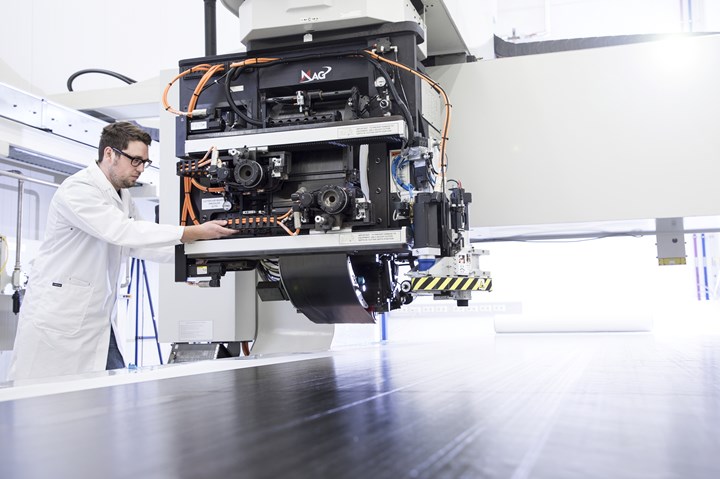FACC emphasizes fast-cure prepregs, thermoplastics, bio-based composites for next-gen aerostructure sustainability
The Tier One’s Sept. 2021 BEyond magazine highlights its investments in new factories, materials and technologies for the next generation of cost-effective, sustainable composites for aviation.

Photo Credit: FACC
FACC (Ried im Innkreis, Austria) is a leading Tier 1 aerospace supplier specializing in the production of lightweight systems for interiors, engines and airframes. In the September 2021 issue of its , FACC highlights its new factory in Croatia for aircraft cabin components, the COMPETE program for its suppliers which stresses materials of the future and three R&D technologies that focus on composites: induction welding, hybrid injection molding and fast-curing prepregs.
FACC in Croatia
Rendering of new, high-tech production facility near Zagreb. Photo Credit: FACC
A high-tech plant is currently being built near Zagreb, Croatia. This 10,000-square-meter facility, scheduled to open in 2022, will produce lightweight cabin components for commercial aircraft and business jets using the latest fiber-reinforced composites technology. “This greenfield investment enables us to create a best-in-class plant that brings together cutting-edge technology, automation and 4.0 methods,” explains FACC CEO Robert Machtlinger. He notes the plant is conveniently located near FACC’s sites in Austria as well as the deepwater port of Koper. The plant also integrates former third-party services into its own value chain and establishes a foundation for future capacity increases.
COMPETE partner program
FACC launched the COMPETE partner program in February 2021 to reportedly strengthen its ties to selected partners and sustainably intensify cooperation. FACC suppliers will have the opportunity to generate new orders despite the ups and downs in the aviation market, but they must first successfully compete against other suppliers. FACC is assessing its suppliers according to the following criteria:
- Cost effectiveness
- Operational excellence
- Materials of the future — innovative materials for a step-change in products and production processes
- Partnership and passion
- Efficiency in all processes — including focused digitalization
- Transparency in quotations
- Environmental and social responsibility.
“COMPETE is all about fair competition and strong partnerships with suppliers that consistently perform well and have a particularly high potential,” says Andreas Ockel, COO of FACC. “We are focusing our future purchasing volume on our COMPETE program partners.” Within the next three years, FACC will redistribute €75 million of purchasing, aiming to decrease from 440 to fewer than 400 suppliers.
Giving more detail about materials of the future, Ockel explains that offering innovation in materials is key: “New fiber-reinforced composites materials shape our future! Snap-cure, fast-curing resin systems that drastically reduce production cycle times is an innovation that introduces genuine step changes in manufacturing processes. We are therefore looking to work closely with suppliers who provide this technological competitive edge.”

Photo Credit: FACC
Sustainability, investment and innovation
FACC asserts that it has helped to increase sustainability in the aviation industry through the aircraft parts it makes using lightweight composites and new aerodynamic shapes. To further reduce global CO2 emissions in the future, the company is working hard to develop technologies that make aircraft even lighter, quieter and more efficient.
FACC is currently researching composites using bio-based and/or bio-sourced materials, which it claims, should soon enable aircraft components to be fully recycled. “It’s about developing biological materials and new processes that consume less energy and offer greater performance but are still affordable,” says Machtlinger.
The company itself is becoming more sustainable, as well, aiming for its plants to be self sufficient in terms of energy and its productions processes to be carbon neutral by 2040. For the current decade, FACC’s Roadmap 2030 includes investments in new facilities like Zagreb, as well as new production methods, highlighted next.
Three R&D initiatives
FACC is developing induction welding of thermoplastic composites to replace screws and rivets in aircraft components and assemblies. An induction coil induces an eddy current in carbon fibers, generating heat (see “Welding thermoplastic composites”). The high-performance thermoplastic is then melted and consolidated in the weld area. Homogeneous welded joints of fiber-reinforced thermoplastic composites are used in rudders, elevators and flaps. They can be joined more quickly and efficiently compared to mechanical fastening or adhesive bonding and can be fully automated.
Hybrid injection molding is described as an efficient way to functionalize fiber-reinforced composites. The process consolidates a semi-finished material into a laminate, which is then heated, reshaped and overmolded using an injection molding compound. A major advantage of this process is that it enables recycling; waste can be reprocessed and used in the injection molding compound. It is also possible to integrate stiffening elements and produce complex components such as aircraft interiors or fairings.
Photo Credit: Adam Rene/FACC; FACC BEyond magazine Sept. 2021, page 29
Fast-curing prepregs offer enormous potential to reduce composites curing time during production by up to 90%. This enables even parts made with thermoset resins to be produced in a matter of minutes, using a robust and energy-efficient process. FACC reports that fast-curing prepregs are simpler to work with than thermoplastic composite materials. The company also sees these materials as a route to improved sustainability, because the resins needed for interior products, for example, can be made from renewable raw materials based on sugar cane, bamboo or algae.
Related Content
Combining multifunctional thermoplastic composites, additive manufacturing for next-gen airframe structures
The DOMMINIO project combines AFP with 3D printed gyroid cores, embedded SHM sensors and smart materials for induction-driven disassembly of parts at end of life.
Read MorePlant tour: Aernnova Composites, Toledo and Illescas, Spain
RTM and ATL/AFP high-rate production sites feature this composites and engineering leader’s continued push for excellence and innovation for future airframes.
Read MoreIndustrializing additive manufacturing in the defense/aerospace sector
GA-ASI demonstrates a path forward for the use of additive technologies for composite tooling, flight-qualified parts.
Read MoreLow-cost, efficient CFRP anisogrid lattice structures
CIRA uses patented parallel winding, dry fiber, silicone tooling and resin infusion to cut labor for lightweight, heavily loaded space applications.
Read MoreRead Next
FACC develops and manufactures composite structures for Ariane 6 launch vehicle
Astris kick stage main structure will be characterized by high strength and the use of ultralight carbon fiber material, with first delivery scheduled for October 2022.
Read MoreCeramic matrix composites: Faster, cheaper, higher temperature
New players proliferate, increasing CMC materials and manufacturing capacity, novel processes and automation to meet demand for higher part volumes and performance.
Read MoreScaling up, optimizing the flax fiber composite camper
Greenlander’s Sherpa RV cab, which is largely constructed from flax fiber/bio-epoxy sandwich panels, nears commercial production readiness and next-generation scale-up.
Read More












